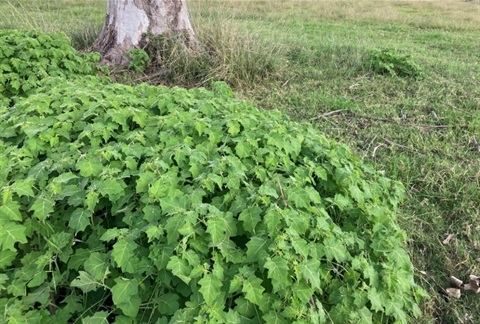Tropical soda apple

Tropical Soda Apple (Solanum viarum)
If you see this plant, call Council or the NSW Department of Primary Industries Biosecurity Helpline on 1800 680 244.
Biosecurity (Tropical Soda Apple) Control Order 2017
In 2017, a Biosecurity Control Order was placed on Tropical Soda Apple, making it one of the highest priority weeds in New South Wales.
Under the order, the plant must be eradicated wherever it occurs in New South Wales and you must notify Council if you become aware of a new infestation.
If the Tropical Soda Apple is part of a new infestation on the land, destroy all Tropical Soda Apple on the land, ensuring that subsequent generations of Tropical Soda Apple are destroyed.
A person who deals with a carrier of Tropical Soda Apple must ensure the plant (and any seed and propagules) is not moved from the land and immediately notify the local control authority of the presence of the plant on the land or in a carrier.
Read more about Tropical Soda Apple and control methods.
How does this weed affect you?
A native of South America, Tropical Soda Apple (Solanum viarum) was first identified in Australia in the upper Macleay Valley in August 2010.
The plant is known to invade open to semi-shaded areas, particularly pastures and riparian zones, but also forests, roadsides, recreational areas, and horticultural and cropping areas.
It reduces biodiversity by displacing native plants and disrupting ecological processes. Its foliage is unpalatable to livestock, thus reducing carrying capacities, but cattle do eat the fruit and spread viable seeds in manure.
Thorny thickets of this plant create a physical barrier for animals, preventing access to shade and water. The plant is a host for many diseases and pests of cultivated crops and contains solasodine, which is poisonous to humans.
Tropical Soda Apple is spread when cattle eat the fruit or the fruit float and move in water. If not controlled, a few plants will form a hectare-sized thicket in six months, with each plant producing 150 fruit containing 45,000 seeds each year. Herbicides kill the plant but do not kill the seeds inside the fruit.
In the United States of America, this plant infested more than half a million hectares in five years.
In New South Wales, it is critical to achieve site-based eradication of this plant before it becomes widespread.
More information
For more information, download the NSW WeedWise app, head to weeds.dpi.nsw.gov.au or speak to a Council Weeds Officer on 6566 3200.